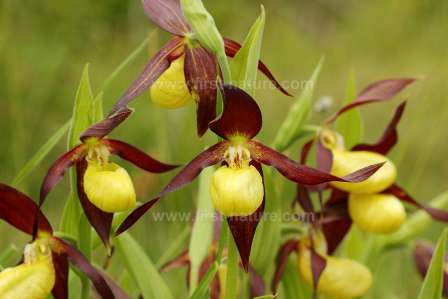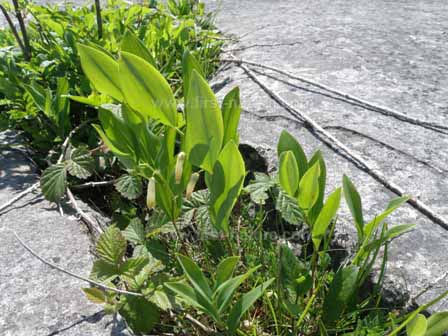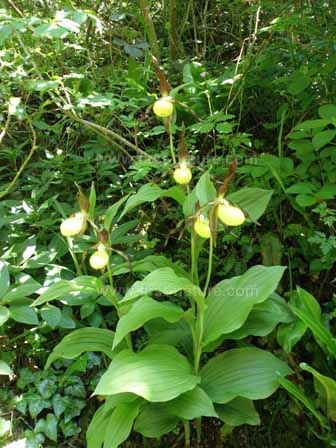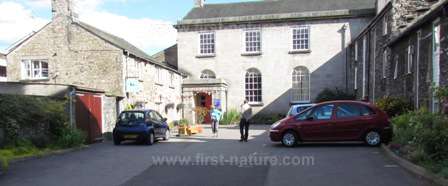Gait Barrows National Nature Reserve, Arnside and Silverdale AONB

A magnificnent Lady's Slipper Orchid from the re-introduction programme at Gait Barrows NNR. Picture by kind permission of Elaine Hagget
Gait Barrows, a National Nature Reserve (NNR) in Lancashire, is managed by Natural England, England's statutory body for care of the countryside and wildlife. The reserve is situated in the Arnside and Silverdale Area of Outstanding Natural Beauty and, apart from its wide variety of wildlife-rich landscapes that support a large number of unusual and rare creatures and plants, Gait Barrows has also been chosen as one of the primary planting sites in the species recovery programme for the Lady's Slipper Orchid - Cypripedium calceolus - Britain's rarest flowering plant.
Gait Barrows NNR truly has something for everybody interested in the natural world. There is a large area of limestone pavement with a host of related plants; Angular Solomon's-seal (Polygonatum odoratum) and the beautiful Dark-red Helleborine (Epipactis atrorubens) both thrive there, and it is one of the best places in Britain to look for moths and butterflies - both the High Brown Fritillary (Argynnis adippe) and Duke of Burgundy (Hamearis lucina) can be found there at the right time of year. The nature reserve is easily accessible and has marked nature trails some of which can be used by wheelchairs, albeit of the more robust kind.

Angular Solomon's-seal (Polygonatum odoratum) in limestone pavement at Gait Barrows NNR
Species Recovery Programme - the Lady's Slipper Orchid
This wonderful flower has become a potent symbol for how much of our wonderful wildlife heritage has been lost and continues to be lost as a result of the many pressures affecting our countryside - increasing industrialisation, commercial and housing development, intensive farming and the use of herbicides and pesticides, and water abstraction to name but a few.
The Lady's Slipper Orchid was recognised as a native European species in 1568, and the earliest record of a British plant is of a dried herbarium specimen from 1640, collected from the Ingleton area in Yorkshire. Although still widespread in some parts of Europe, the Lady's Slipper Orchid was always a rarity in Britian and consequently highly prized by plant collectors who, from the mid-18th Century, collected the plants with such ruthlessness that by 1888 great concern was being expressed at the disappearance of the Lady's Slipper Orchid from the wild. Regrettably the population continued to decline, resulting in its declared extinction by 1917.

Lady's Slipper Orchid - the Silverdale Plant
In 1930 a single plant was discovered in Yorkshire, on a privately-owned site where visiting is strictly prohibited. As a result of close protection this plant continues to grow and is gradually increasing in vigour and flowering performance. The intense concern about the survival of this single plant led ultimately to the formation of the Cypripedium Committee, an organisation made up from members of Natural England, Yorkshire Wildlife Trust and the Yorkshire Naturalists Union; their primary aim was to ensure the safety of the single surviving plant. A secondary aim has been to propagate the plant and to attempt to re-introduce it to some of its former flowering sites, so that Lady's Slipper Orchids could be visited and enjoyed by the public. By this time, two other specimens of our native Lady's Slipper Orchid, collected from the Ingleton area of Yorkshire at the turn of the Century, were known of; these plants, which provide important genetic material, were being maintained in cultivation for possible cross-pollination with plants grown for the purposes of re-introduction. This long and difficult process received a major boost when in 1983 a generous donation was made by Sir Robert and Lady Sainsbury, resulting in the establishment of the Sainsbury Orchid Project at the Royal Botanic Gardens at Kew, in London.
After much work and many setbacks a reliable technique for the mass-reproduction of seedlings and a method for weaning the seedling plants have been established. As a result, in the autumn of 1989, the first seedlings were planted in the wild. Today, despite the many dangers and predations that threaten these young plants, there are some thriving young Lady's Slipper Orchids in a number of sites. It will be many years, however, before a healthy population of Lady's Slipper Orchids, free from the threat of extinction, can be established.
The Silverdale Plant
This specimen of the Lady's Slipper Orchid is thought to have been planted in Victorian times in some form of landscape gardening. It has been cared for over many years by dedicated local naturalists and has received formal protection since 2000 to ensure that visitors to the plant enjoy it without having a damaging impact on the plant and its location. As a result of an intensive programme of care, this is now a vigorous and beautiful plant with many gorgeous flowers. Controlled public access to this plant provides an opportunity for people to see the Lady's Slipper Orchid without adding pressure to the true wild sites where the re-introduced plants are in their most fragile stage of growth and development.
Despite all the care and protection given to the Silverdale plant it has been attacked by plant thieves on several occasions, and so access to it remains under review. Of all the threats that exist to our rare and beautiful wildflowers in Britian, human predation remains one of the greatest. Those selfish and obnoxious individuals who pick the flowers or dig up rare plants would do well to heed the words written about one of their kind, a Miss Thomasin Tunstall, who was responsible for so much collection and the resulting disappearance of many specimens of the Lady's Slipper Orchid in the 1600s:
'A worthy Gentlewoman indeed! O Mistress Thomasin if only you had loved these delights a little less ruinously for future generations! Do you sleep quiet, you worthy Gentlewoman, in Tunstall Church or does your uneasy sprite still haunt the Helks Wood in vain longing to undo the wrong you did? "Accursed for evermore, into the lowerest of the Eight Hot Hells, be all reckless uprooters of rarities". John Parkinson, 1629.
Kendal is the nearest of the Lake District towns to Gait Barrows and well worth a visit if you are in the area. There are a number of attractions to visit in the town, but the outstanding one for us during our visit was The Quaker Tapestry Exhibition Centre and Cafe. Housed in one of the finest Georgian buildings in Cumbria, the Friends Meeting House in Kendal is a grade 2* listed building designed by local architect Francis Webster in 1816. The beautiful walled garden offers an oasis of tranquillity just a short stroll from the high street, and a friendly welcome to all. With its own car park, cafe and shop this is an excellent and convenient place to drop by and enjoy the 77 panels of exquisite embroidery in the exhibition, and to buy gifts for friends and family. The cafe, which is open for coffee, lunch and afternoon tea offers award winning dishes prepared from fresh local ingredients.

The Quaker Tapestry Exhibition Centre and Cafe in Kendal
Sue Parker's latest ebook is a revised and enlarged second edition of the acclaimed Wildflowers in the Algarve - an introductory guide. Full details here...
Buy it for just £3.95 on Amazon...
Please Help Us: If you have found this information interesting and useful, please consider helping to keep First Nature online by making a small donation towards the web hosting and internet costs.
Any donations over and above the essential running costs will help support the conservation work of Plantlife, the Rivers Trust and charitable botanic gardens - as do author royalties and publisher proceeds from books by Pat and Sue.



